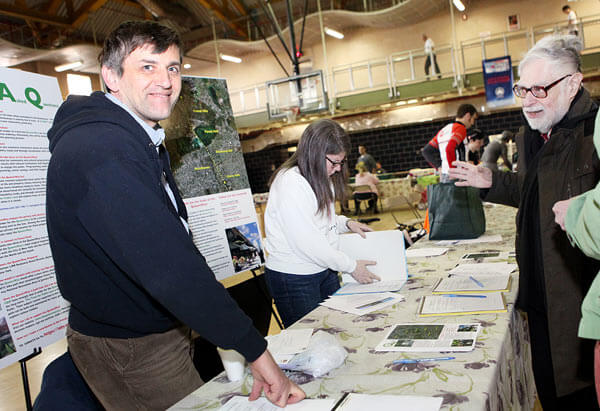By Bianca Fortis
Advocates for a new park in Queens are quickly moving closer to seeing their vision become reality.
The project proposes transforming 3.5 miles of the deactivated Rockaway Beach branch into a public park, similar to Manhattan’s High Line.
Operated by the Long Island Rail Road, the branch ran from Rego Park into the Rockaway Peninsula. Service ended more than 50 years ago and the line has sat in disrepair every since.
Advocates say completion of the project, called the QueensWay, would result in 132,000 square feet of new park space and an opportunity for new economic development in Queens.
The nonprofit Land in the Public Interest will soon announce the winner of a contract for a safety and feasibility study of the project.
Marc Matsil, the New York state director of the group, said the study, which will include community input, will help determine a final cost of the project as well as an environmental analysis of it.
The study itself will cost about $400,000, funds that were provided by a grant through the governor’s office.
Matsil said his group is advocating on behalf of the project because it would help better serve parkland.
“More than 70 percent of local Queens residents take a car to Forest Park because they can’t access it safely,” he said. “This would make it easier to ride to there. It provides active recreation and it provides the ability to access a magnificent park in the park system.”
Travis Terry founded Friends of the QueensWay to promote the project. He said there is evidence that greenway conversion leads to improved public safety.
“You can look at what greenways, not just the High Line, but greenways around the world have done for communities,” said Terry, who lives in Forest Hills. “It’s all just for the betterment of the community.”
But there is opposition from some who would rather use the abandoned train line for another purpose.
Phil McManus, founder of the Queens Public Transit Committee, said the decision to shut down the rail line has led to isolation for Rockaway residents from the rest of Queens, as well as a languishing local economy. That further contributes to high poverty and crime rates.
“The Rockaway Beach line is only the tip of the iceberg,” the lifelong Rockaway resident said. “It becomes an issue of who has and who doesn’t.”
Rockaway lost service on the line in 1950 when the trestle connecting The Raunt and Broad Channel stations caught fire. The rest of the line shut down in 1962.
Residents of the peninsula must grapple with slow travel times on the A train, inconsistent buses and a $3.25 toll on the Cross Bay Bridge. Reactivating train service could first benefit commuters, but it could also spur development in southern Queens, which would help ease the congestion that burdens the rest of the city, McManus said.
“People think this is just about Rockaway,” he said. “But I want to improve Queens as a whole for everybody.”
Residents of some neighborhoods like Rego Park and Forest Hills oppose the train because they believe it will contribute to noise pollution in their areas and could affect property values.
Terry said he is not “anti-train,” but reactivating service is just unlikely.
“I’ve looked at the evidence,” he said. “It’s just clear to me that a train is never going to happen.”
He noted a 2001 feasibility study in which the Metropolitan Transportation Authority determined reactivating train service would be impractical for cost and environmental reasons.
Matsil said reactivating the line is unrealistic because new communities have sprung up around it since service ceased. He also said about a third of the line is already mapped parkland, so restoring train service would constitute the loss of about 20 acres of already mapped parkland, which would need to be replaced with a parcel of equal size.
Despite the challenges, McManus is not giving up. There are many people, including elected officials such as Assemblyman Phillip Goldfeder (D-Ozone Park), who are supporting the cause.
“We don’t want to bring anybody down,” McManus said. “We want to bring everybody up. Mass transit should be fair.”
To contact McManus about the Queens Public Transit Committee, e-mail him at rowing612@aol.com.
For more information about the QueensWay project or to get involved, visit thequeensway.org.
Reach reporter Bianca Fortis by email at bfortis@cnglocal.com or by phone at 718-260-4546.
































